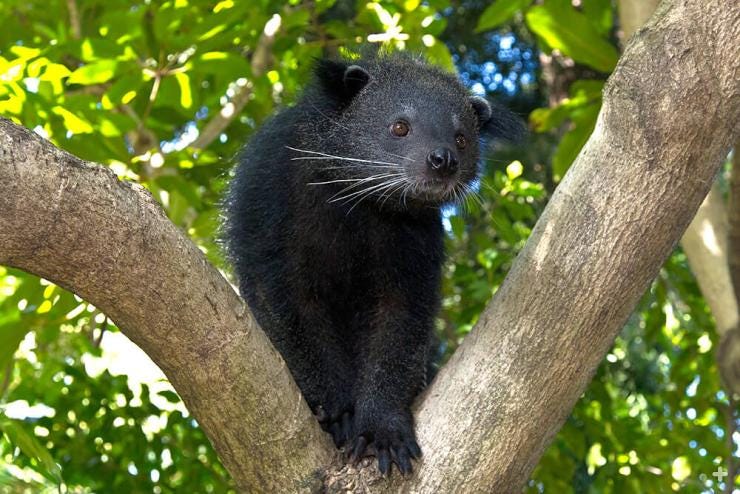Thoughts This Week - 2025/04/18
Pee that smells like popcorn, lasers from planes, and pistachio coffee

I had no idea that… popcorn smells like a bearcat’s pee (or the other way around?). Apparently, binturongs—a.k.a. bearcats—rely on urinary scent to signal when it’s time to get it on. A compound in their urine called 2-acetyl-1-pyrroline (2-AP) produces the signature smell that reminded one journalist of a movie theater lobby.
Laser Archeology

When I first heard that archaeologists were shooting lasers from airplanes to find lost cities, I imagined something out of Star Wars. It turns out, this isn’t science fiction at all—it’s happening right now, and it’s revolutionizing how we explore the past. The technology is called LiDAR (short for Light Detection and Ranging), and it’s basically like radar with lasers. By beaming millions of laser pulses from the air and measuring the reflections, LiDAR creates incredibly detailed 3D maps of the ground surface. In practical terms, it lets archaeologists “see” through dense forests, jungles, and other inaccessible places without even touching a machete
To give you an idea of how powerful this is, let’s start in the Amazon rainforest, one of the last places on Earth I’d have expected to find ancient urban centers. For centuries, humans chased legends of Amazonian cities of gold (e.g., El Dorado). Most returned empty-handed (or never returned at all), and many scholars assumed the Amazon was too wild to have ever hosted large cities. But in 2022, researchers mounted a LiDAR scanner on a helicopter and “digitally deforested” part of the Bolivian Amazon—essentially peeling away the thick canopy in the data to reveal what lies beneath. What they found redefines narratives of history: a vast urban settlement from about 500–1400 AD (pictured above), with monumental platforms and pyramids rising up to 70 feet high, connected by long raised causeways. In other words, a whole invisible city was hiding in plain sight under the trees. This discovery is a game-changer, suggesting that the Amazon “wilderness” actually contained heavily populated, urbanized centers centuries ago.
My background isn’t in archeology, but I find this technology incredibly interesting for the field of history. History isn’t a fixed set of known facts – it’s an unfolding story, and technology like LiDAR is adding whole new chapters. It makes me wonder (and excited to find) what else is out there.
Pistachio Coffee
I’m always on the lookout for new coffee shops, so when a Kurdish coffeehouse opened a few blocks from my home (Muri I, for any San Diegans reading this), I swooped in. The cafe serves excellent espresso-based drinks and Middle Eastern pastries, but the menu item that caught my eye was Qazwan—mainly because I had no idea what it was!
Qazwan coffee, also known as Kurdish coffee or pistachio coffee, comes from Kurdistan. Though it’s colloquially called “coffee,” the beverage actually contains no coffee beans or caffeine. Instead, it is made using ground, roasted terebinth fruits, which are related to pistachios. The reason why it’s associated with coffee is due to how it’s prepared and enjoyed. Similar to Turkish coffee, Qazwan is prepared in a cezve using very finely ground roasted terebinth fruits, without the use of filters or settling to remove the grounds from the drink. When served, the remains of the terebinth fruits collect at the bottom of the drinking vessel.
So, what does Qazwan taste like? In case you’re wondering, I took notes! I’d describe the flavor as earthy, nutty, and slightly bitter. The texture of the drink is thick—about the same consistency as sahlep, Turkish coffee, or a very thick hot chocolate. Typically, Qazwan is served in small cups (such as the picture above), accompanied with a glass of water and a sweet confection to balance the intensity of the drink. I was instructed to sip the drink rather than down it quickly like an espresso.
If you’ve never tried Qazwan before, I’d recommend hunting for a provider in your area or buying a bag online.
Pitch Accent
Okay, so this section is technically cheating since I learned about pitch accent a while ago, but anyone who knows me knows that when you get me started talking about learning Japanese pitch accents, I won’t shut up about it.
I’m going to assume that most of you reading this are fluent in English (if not, wow, you’re extremely impressive!). English is a stress-accent language. In the context of words, that means that emphasis is placed on a specific syllable by increasing its loudness, duration, and pitch.
For example, let’s look at the word “refrigerator.”
The stress in this word is placed on the second syllable, “fri.” The speaker (me) increases in volume and pitch, and lengthens the sound. Many English words follow this pattern by placing stress on the second syllable of the word, such as important, political, particular, additional, conventional, remote, etc.
You might be like me and have never paid much attention to the stress in English words, but the language is littered with them. Even sentences are stressed to denote emotion or clarify points.
Japanese, on the other hand, is not a stress-accent language. It employs pitch to distinguish words and convey meaning. Pitch accent refers to the way the pitch of the voice rises and falls within a word, creating a tonal pattern. Japanese speakers do not place stress on the sound components of their words (Japanese uses moras, but let’s not open that can of worms here).
Let me give you an example with the help of a native speaker (my husband). The word “cute” in Japanese is かわいい (kawaii). When learning the language, many native English speakers mispronounce kawaii by misplacing the pitch accent. They stress “wa” like they would an English word. Let’s compare the incorrect and correct pronunciations below.

Incorrect pitch accent that mimics English emphasis:
Correct pitch accent:
I bring this topic up because I find it fascinating to discover the inner workings of languages that I study. I think learning these kinds of linguistic components early can help foster good habits and make you sound more “natural” to a native speaker.
Upcoming…
You may have noticed that I missed an entry last week. I apologize for that—I’m close to finishing the second draft of my novel and had a very busy week at work, so I wasn’t able to get anything out last Friday.
I hope to have the novel draft completed by next week, so I should have the capacity to jump back into my Deep Dive series, as well as read more interesting stuff that I can share in posts like these (it’s difficult to read when you’re typing out thousands of words a day!).
In the meantime, as always, I hope you found these discoveries as interesting as I did.
- Blake




